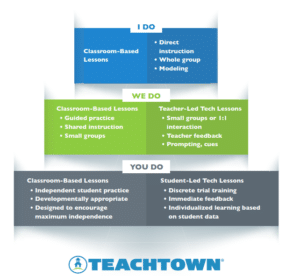In every classroom, a teacher must determine the ways in which students will engage in learning from a list of instructional methodologies. The phrases instructional methodology, teaching method, instructional method all describe how a teacher is delivering instruction to help students meet the lesson objective. There are a variety of evidence-based methods from which to choose, and expert teachers often use a combination to best support the wide range of student needs and strengths in their classroom. Read on to learn about three of them!

Discrete Trial Training is another evidence-based instructional method in which a specific skill is broken down into smaller steps. When using DTT, the teacher provides explicit, specific instruction to teach the skill; prompting hierarchies are incorporated as appropriate to support learning via error correction and reinforcement. Advantages of this type of instruction are that it can be done one-on-one or in group settings and is appropriate for all domains of learning (academic, communication, social skills, etc.). It also is commonly utilized when targeting IEP goals since DTT is typically done in mass trials and its structure allows for clear progress monitoring.
Let’s use the example teaching the skill of identifying coins. The teacher would work directly with the student by showing them a coin and stating a phrase such as, “This is a quarter.” Then, they would instruct the student to identify the coin as well by either stating the name or touching the coin. The teacher would systematically fade out prompting until the student is able to independently identify the coin when asked.
Once the teacher has identified the subject matter and teaching approach, they must then differentiate the material to suit each student’s needs. This can involve incorporating visual aids such as images alongside text, utilizing graphic organizers, or adding sentence frames to facilitate writing tasks. Interactive whiteboards or smart boards can serve as effective tools for conducting real-time demonstrations and engagement with the material. Hands-on materials like blocks, counters, or math kits can provide tactile learners with tools to further their learning opportunities. Teachers may choose various methods of support, with one student receiving more assistance while another works towards meeting established standards. For instance, in a lesson on addition and subtraction, one student might utilize a graphic organizer to write their answers, while another uses manipulatives to physically represent the mathematical concepts.
Teaching diverse learners includes an array of instructional methodologies, each tailored to address the unique needs and strengths of students within a classroom. Whether employing the gradual release model to foster independent learning, implementing discrete trial training to systematically build skills, or utilizing scaffolding techniques to provide differentiated support, educators continually adapt and refine their approach to meet the needs of their students. With these tools in hand, teachers create a dynamic learning environment where every student can thrive and reach their full potential. By trying out new ideas and putting them into practice, teachers set the stage for long-lasting academic achievements.
Contributor Bios
Katie Giberson, M.Ed., currently serves as an Account Manager at TeachTown, as well as an adjunct college professor. Previously, Katie worked as a special education teacher in New York City for nearly 10 years and has extensive experience in professional development and project management. She received her Master’s Degree in Adolescent Special Education from Hunter College and was in the New York City Teaching Fellows program. Katie excels in using data to inform roadmaps, accelerate outcomes, and achieve growth for partners and students alike.
Emily Ippolito, M.Ed., BCBA, is a Product Enablement Specialist and Board Certified Behavior Analyst at TeachTown. Prior to TeachTown, Emily worked in both public and residential schools as a Special Education Teacher certified in severe special education. Emily also worked as a BCBA consultant to public schools as well as in home and clinic services for clients from preschool through adulthood. Emily has a Master’s Degree in Severe Special Education from Simmons University and a post-graduate certificate in Applied Behavior Analysis from Fitchburg State University.